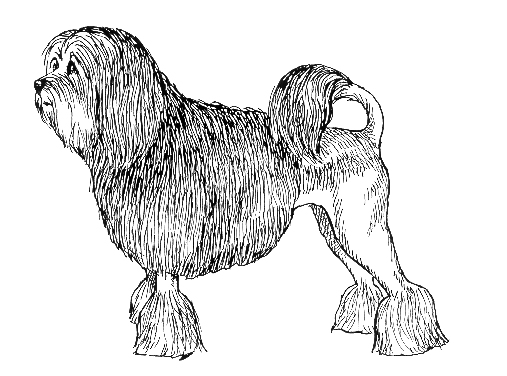Lowchen
Companion Dog Group
The goals and purposes of this breed standard include: to furnish guidelines for breeders who wish to maintain the quality of their breed and to improve it; to advance this breed to a state of similarity throughout the world; and to act as a guide for judges.
Breeders and judges have the responsibility to avoid any conditions or exaggerations that are detrimental to the health, welfare, essence and soundness of this breed, and must take the responsibility to see that these are not perpetuated.
Any departure from the following should be considered a fault, and the seriousness with which the fault should be regarded should be in exact proportion to its degree and its effect upon the health and welfare of the dog and on the dogs ability to perform its traditional work.
History
The Lowchen is a very old breed, having been established as far back as the 1500's in Europe, specifically in Spain, France and Germany.
The Lowchen was recognized by the United Kennel Club on January 1, 1995.
General Appearance
The Lowchen is a small, bright, lively dog that originated as a companion breed in pre-Renaissance Europe where ladies of the court groomed it in the likeness of a little lion. The body is approximately square when properly balanced.
Characteristics
The Lowchen is alert, intelligent, and affectionate, with the overall qualities of a loving companion dog. It has a lively, outgoing, and inquisitive personality.
Head
Relatively short and broad, carried high.
SKULL
The skull is flat and broad, the same length as width. It joins the muzzle at a moderate stop.
MUZZLE
The muzzle is about two-thirds the length of the skull. It is fairly broad, and straight, with tight lips that are black, except in the dogs with brown coats, when they are dark brown.
TEETH
A full complement of strong, rather large, well spaced, white teeth meet in a scissors bite. Missing first premolars are not to be faulted. Any other missing teeth are serious faults, as are overshot and undershot bites.
EYES
The eyes are set well into the skull. They are large and rather round in shape. They are set well apart and forward-looking. They are dark in color and the eye rims are fully pigmented. The expression is attentive and tender.
Serious Faults: Functional abnormalities of the eyelids (entropion, ectropion).
NOSE
The nose is set in line with the topline of the muzzle. It must be fully pigmented and black in color, except in the brown-coated dogs, when it is dark brown.
EARS
The ears are pendant, well fringed, and set on level with the eye. In length, they reach nearly to the middle of the muzzle when pulled forward.
Neck
The slightly arched neck is of good length and fits smoothly into the shoulders and backline.
Forequarters
The moderately long shoulders are sloping, well muscled, and have free action.
FORELEGS
The forelegs are of good length, perfectly straight, and the elbows are held close to the body. The round bone is medium in size, and the pasterns are short and slightly sloping. The dewclaws may be removed.
Body
The distance from the prosternum to the end of the pelvis is approximately equal to the distance from the withers to the ground. The topline is level from withers to tailset. The chest is deep to the elbow. The loin is short and strong. There is a well-defined tuck-up.
Hindquarters
The pelvic bone is moderately long, projecting beyond the set of the tail. It is set at an approximate 45-degree angle from a perfectly horizontal line.
HIND LEGS
The well-muscled upper and lower thighs are of approximately equal length, and have medium bone. The hocks are well let down and have normal angulation. The rear pasterns are strong and perpendicular to the ground. Rear dewclaws should be removed.
Feet
Small and round, with tight, well-arched toes. A splayed foot is to be penalized.
Tail
The tail is set moderately high. It is carried elegantly over the back, but the tip never touches the back, only the tail plume touches the back.
Serious Fault: Ring tail.
Coat
Silky, long, dense and wavy, without undercoat.
TRIM
The Lowchen is customarily shown in the Lion Trim. The coat is clipped to about one-eighth of an inch from the ribs back to, and including, the hindquarters. A ruff, or mane, that just covers to the last rib is left. The front legs are clipped from the elbow to a point just above the knee, which is equal to the same distance from the ground to the hock joint. The hindquarters are clipped to the hock joint. This leaves cuffs of hair on all four legs.
The tail is clipped from the base to approximately one-half way from the tip, leaving a plume at the end of the tail. The feet are clipped to the dewclaws.
The coat is left at natural length on the head, neck, shoulders, and forward body. These unclipped areas must be completely untrimmed. On no account should the unclipped areas be smoothed, shortened, shaped, or otherwise tidied.
Disqualifications: Any trimming other than indicated. Any shaping or scissoring of the long coat.
Color
All colors and color combinations are acceptable, with no preference given to any.
Disqualification: Albinism.
Height & Weight
The preferred height range is from 10 to 12 inches, measured at the withers.
The approximate weight is 13 pounds.
Gait
Lively, upstanding, with good reach and high head carriage. The legs are parallel in action.
Disqualifications
(A dog with a Disqualification must not be considered for placement in a conformation event, and must be reported to UKC.)
Unilateral or bilateral cryptorchid.
Viciousness or extreme shyness.
Any trimming other than indicated.
Any shaping or scissoring of the long coat.
Albinism.

Looking for a Dog?
Find a dog that will fit your family.
Note: The breeders on this list are not endorsed by UKC.
Revised May 1, 2017
©Copyright 1995, United Kennel Club
